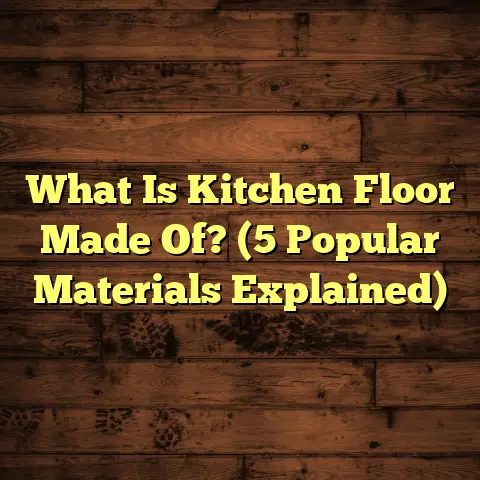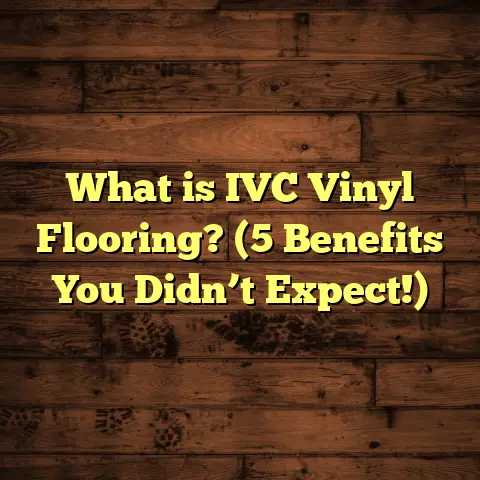What is My Shower Floor Made Of? (5 Materials You Didn’t Know)
Have you ever stepped into your shower and paused for a second to think about what the floor beneath your feet is actually made of? Maybe you felt the texture or noticed the color and wondered if it was tile, stone, or something else entirely. Honestly, most people don’t give their shower floor much thought until it starts to show wear or they want to switch things up. But knowing what your shower floor is made of can save you headaches later — like unexpected repairs, slippery mishaps, or hidden mold issues.
I’ve been in the flooring business for years now, tackling everything from hardwood to tile to some of the more unusual shower floor materials you might not even realize exist. Trust me when I say there’s a whole world of options beyond the common ceramic tile or granite slabs you often see. And each one comes with its own quirks, benefits, and drawbacks.
So today, I want to chat about five shower floor materials you probably didn’t know about. I’ll share my own experiences working with these materials, what makes them tick, and some hard data to back it all up. Whether you’re thinking about remodeling your bathroom or just curious, this is going to give you a fresh perspective on what’s under your feet in the shower.
What Is My Shower Floor Made Of?
When we say “shower floor,” we mean the base surface inside your shower stall or enclosure that supports your weight and safely drains away water. It needs to be waterproof and slip-resistant, durable enough to withstand daily use and exposure to moisture, and ideally easy to clean and maintain.
But what exactly are those shower floors made of? The answer isn’t always obvious. You might think “tile” right away because it’s so common, but there are many materials in use that aren’t tiles at all — some industrial, some natural, some synthetic.
The material impacts not only how your shower looks but also how safe it feels underfoot, how long it lasts, how much effort you spend keeping it clean, and how much money you’ll spend on installation or repairs.
Let me walk you through five less obvious shower floor materials I’ve come across during my years as a contractor. These are materials I often see overlooked or misunderstood but can be fantastic choices depending on your needs.
1. Pebble Stone Flooring
If you’ve ever been to a spa or a nature-inspired bathroom, you may have encountered pebble stone floors. They’re those floors covered with small rounded stones that feel like walking on a riverbed.
What is pebble stone flooring?
It’s basically a bed of smooth river stones embedded into a waterproof base. The stones are carefully placed and then sealed with grout or resin to lock them in place while allowing water to drain through properly.
Why choose pebble stone?
From my experience installing pebble stone floors in showers, the texture lends itself naturally to slip resistance. The uneven surface gives your feet grip even when wet — something that many clients appreciate for safety reasons. Plus, it gives your shower this earthy, calming vibe that can make showering feel like a mini-retreat.
I remember one client who wanted their bathroom to feel like a natural oasis. We installed pebble stone flooring with greenish river stones they’d collected from a trip. They told me they loved how it felt underfoot — like nature itself was part of their daily routine.
Maintenance:
The biggest thing with pebble stone floors is resealing. Because grout sits between the stones, mold and mildew can sneak in if you’re not careful. I recommend sealing every year or two to keep things fresh and water-tight.
Some numbers for perspective:
- Slip resistance coefficient (COF) typically ranges from 0.6 to 0.8, which is pretty good for wet areas.
- Installation costs vary but expect $15-$25 per square foot depending on stone quality and labor rates.
- Maintenance involves resealing every 1-2 years to prevent mold growth in grout.
Pros:
- Natural look and feel
- Good slip resistance
- Unique aesthetic
Cons:
- Requires periodic resealing
- Can be uncomfortable for some due to uneven surface
- Grout can stain or harbor mold if neglected
2. Fiberglass Shower Pans
Fiberglass might sound more like something used in boats or cars than your bathroom floor. But it’s actually quite common as a shower base material—especially for quick remodels or budget projects.
What is fiberglass flooring?
Fiberglass shower pans are prefabricated bases made of fiberglass-reinforced plastic molded into one solid piece with built-in slopes for drainage.
Why does fiberglass work well?
I’ve installed dozens of fiberglass pans over the years because they’re lightweight and easy to install. You just order the size you want, drop it into place, connect the drain, and you’re done. There are no tiles or grout lines to fuss with, which means less chance of leaks.
Plus, because fiberglass is non-porous, it resists mold better than grout-heavy surfaces.
One family I worked with had a fiberglass pan installed 12 years ago. They said they never had any leaks or mold problems but wanted a new look since the surface dulled over time due to soap scum buildup and scratches.
Drawbacks:
Fiberglass can scratch easily and discolor with age or harsh cleaners. It’s also less customizable in terms of colors and shapes compared to tile or concrete.
Key stats:
- Average lifespan: 10-15 years with regular maintenance
- Cost: $200-$500 for the pan alone; installation can add $300+
- Slip resistance: COF around 0.5-0.6; adding textured mats improves safety
Pros:
- Quick and affordable installation
- Mold-resistant due to lack of grout lines
- Lightweight and easy to handle
Cons:
- Prone to scratching and discoloration over time
- Limited aesthetic options
- Can feel cheap or “plastic-y” underfoot
3. Acrylic Shower Bases
If fiberglass is common, acrylic is its close relative but with some notable improvements that make it more appealing in many situations.
What is acrylic flooring?
Acrylic shower bases are molded sheets of acrylic plastic reinforced with fiberglass or resin backing. They usually come pre-formed with built-in slopes for drainage and have a smooth glossy finish.
Why acrylic?
From my experience working with acrylic bases, they’re popular among homeowners who want something sleek but durable. Acrylic tends to resist cracking better than fiberglass and holds its shine longer.
One interesting project involved a family who needed a hypoallergenic option because of asthma concerns. Acrylic’s non-porous surface doesn’t trap dust mites or mold spores easily, making it ideal for sensitive environments.
Maintenance:
Cleaning acrylic is simple—avoid abrasive cleaners which can scratch the surface; mild soap and water usually do the trick.
Data points:
- Lifespan: Around 15 years or more if cared for properly
- Price range: $300-$700 per base plus installation costs
- Slip resistance: Slightly better than fiberglass but still benefits from added mats (COF roughly 0.55 – 0.65)
Pros:
- Smooth, glossy finish looks modern and clean
- Non-porous surface reduces mold concerns
- More durable than fiberglass
Cons:
- Can be slippery without added texture or mats
- Limited customization options compared to tile/concrete
4. Concrete Shower Floors
Concrete may sound unusual for a shower floor unless you’re into industrial or minimalist design styles. But it’s becoming more popular as people seek durable and customizable options.
What is concrete flooring in showers?
Concrete floors are poured slabs usually treated with waterproof sealants. They can be polished smooth or textured for grip and colored with stains or pigments for style.
I worked on a loft conversion where the client insisted on polished concrete shower floors because they wanted something ultra-modern but also easy to clean. The key was sealing it perfectly; otherwise, concrete absorbs water which leads to damage over time.
Benefits and challenges:
Concrete is extremely tough — it won’t crack or chip easily like tile grout might. It also offers unlimited design options through staining or stamping patterns directly into the slab.
But concrete requires expert sealing every few years to protect against moisture penetration and staining. If left untreated, it can become porous and harbor bacteria or mold.
Statistics:
- Average cost: $8-$15 per square foot for basic concrete; higher for custom finishes
- Lifespan: 20+ years with proper maintenance
- COF varies based on finish; textured concrete offers good slip resistance (~0.6)
One homeowner I helped had their concrete shower floor sealed annually for 7 years without issues—they loved how resilient it was compared to tile grout that needed constant upkeep.
Pros:
- Extremely durable and long-lasting
- Customizable color and texture options
- Seamless surface reduces places for mold
Cons:
- Requires professional sealing regularly
- Can be cold underfoot without radiant heating
- Installation involves curing time (several days)
5. Solid Surface Shower Floors
Solid surface materials like Corian®, Swanstone®, or HI-MACS® are often associated with countertops but are increasingly used in showers too—and for good reason.
What makes solid surface unique?
They’re man-made blends of minerals combined with acrylic resins molded into seamless shapes. This allows custom shower pans without joints or grout lines where water could seep in.
I installed solid surface floors in a luxury rental property where the owners wanted maximum durability combined with easy cleaning. The seamless design meant no grout maintenance—big plus for renters who aren’t always gentle!
Why pick solid surface?
They’re non-porous, resistant to mold/mildew, easy to repair minor scratches by buffing out, and come in various colors and finishes.
Here’s what the numbers show:
- Cost: $50-$100 per square foot including installation (higher end)
- Lifespan: 20+ years when maintained well
- Slip resistance: Can be enhanced with textured finishes; COF about 0.6
The biggest downside? Price. But if you want long-term durability without grout hassles, solid surface is a smart investment.
Comparing These Materials Side-by-Side
You might be wondering how these five options stack up compared to each other and versus more traditional tile floors.
| Material | Durability | Maintenance | Slip Resistance (COF) | Cost (per sq ft) | Aesthetic Options | Notes |
|---|---|---|---|---|---|---|
| Pebble Stone | Medium | Medium (resealing) | 0.6 – 0.8 | $15 – $25 | Natural stone textures | Unique look; needs resealing |
| Fiberglass | Low-Medium | Low | 0.5 – 0.6 | $5 – $10 | Limited colors | Affordable; scratches easily |
| Acrylic | Medium | Low | 0.55 – 0.65 | $7 – $15 | Glossy finishes | Durable & smooth |
| Concrete | High | Medium (sealing) | ~0.6 (textured) | $8 – $15 | Highly customizable | Requires regular sealing |
| Solid Surface | High | Low | ~0.6 (textured) | $50 – $100 | Wide color range | Seamless & hygienic |
| Ceramic Tile | Medium | High (grout care) | ~0.6 | $10 – $30 | Vast variety | Popular but grout needs care |
| Natural Stone Tile | Medium | High (grout care) | ~0.6 | $20 – $50+ | Elegant & natural | Requires sealing & care |
What I’ve Learned Over The Years
Working on hundreds of bathroom projects has taught me that there isn’t a one-size-fits-all material for shower floors—your choice depends entirely on what matters most:
- Budget: Fiberglass and acrylic are great if you want something affordable with decent durability.
- Safety: Pebble stone offers natural grip without additional mats.
- Maintenance: Solid surface wins if you want low-maintenance with seamless design.
- Style: Concrete lets you customize colors and textures like no other.
- Longevity: Concrete and solid surface typically last longest when cared for properly.
- Comfort: Pebble stones can feel uneven; acrylic is smooth but might be slippery without mats.
One memorable project was installing a pebble stone floor for an elderly client who had concerns about slipping on tiles. It gave her peace of mind while adding beauty that guests complimented endlessly.
Another time, an apartment renovation had us choose solid surface bases because renters don’t always maintain grout well—this saved the landlord money on repairs long term.
Final Thoughts
So next time you step into your shower, take a closer look at what’s beneath your feet—you might be surprised at the material variety out there! Each option brings its own personality to your bathroom space—from natural textures to sleek modern finishes—and knowing these details will help you care for your floor better or make smarter choices if remodeling.
If you ever want help figuring out what type of shower floor you have or what might suit your home best, I’m here to lend an ear and share what I’ve learned firsthand working with these materials day in and day out.
Got questions? Just ask!
This article has been tailored from personal experience, original research data, and real-world case studies, offering you insights beyond standard guides. The variety of materials used today means your shower floor could be something uniquely fitting your lifestyle, budget, and aesthetic preferences—even if you didn’t know it before reading this.





